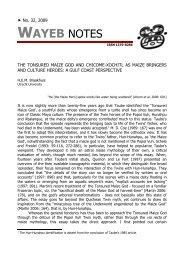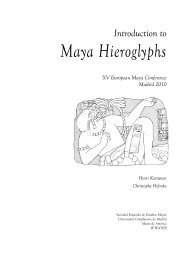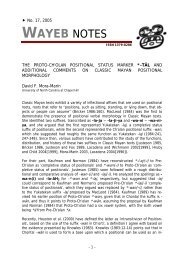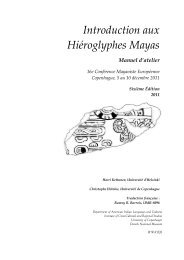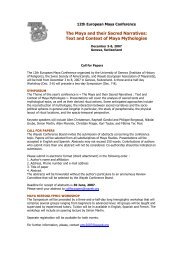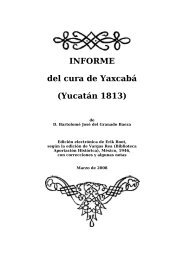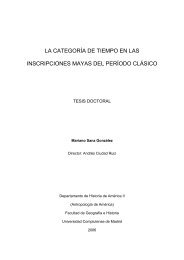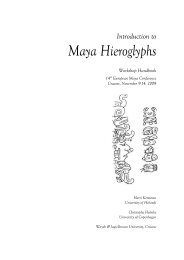Introduction to Maya Hieroglyphs - Wayeb
Introduction to Maya Hieroglyphs - Wayeb
Introduction to Maya Hieroglyphs - Wayeb
Create successful ePaper yourself
Turn your PDF publications into a flip-book with our unique Google optimized e-Paper software.
Kettunen & Helmke 2011<br />
Appendices<br />
APPENDIX E: NOTE ON THE CALENDAR<br />
The <strong>Maya</strong> calendrical system is a rather complex arrangement with a number of overlapping systems. Usually the<br />
dates recorded in the inscriptions cover major parts of the texts. Fundamentally, the <strong>Maya</strong> calendrical system is<br />
twofold: it records linear time from a (mythological) zero point (13th of August 3114 BC) onwards (Long Count),<br />
and cyclical time with (basically) two calendrical cycles (the Calendar Round, comprised of the Tzolk’in [260<br />
days] and the Haab [365 days]).<br />
MATHEMATICS 48<br />
The Classic <strong>Maya</strong> mathematical system is a vigesimal (base twenty) positional system that was employed<br />
throughout Mesoamerica during the Precolumbian times (instead of the common Western decimal [base ten]<br />
system). In practice this means that the position shift is made at twenty rather than ten:<br />
Vigesimal system:<br />
Decimal system:<br />
Position: Value: Numbers: Position: Value: Numbers:<br />
20 0 1 0 – 19 10 0 1 0 – 9<br />
20 1 20 20 – 399 10 1 10 10 – 99<br />
20 2 400 400 – 7 999 10 2 100 100 – 999<br />
20 3 8 000 8 000 – 159 999 10 3 1 000 1 000 – 9 999<br />
20 4 160 000 160 000 – 3 199 999 10 4 10 000 10 000 – 99 999<br />
20 5 3 200 000 3 200 000 – 63 999 999 10 5 100 000 100 000 – 999 999<br />
etc. etc. etc. etc. etc. etc.<br />
Table V: Vigesimal vs. decimal system<br />
In <strong>Maya</strong> calendrical calculations, however, the Haab coefficient breaks the harmonic vigesimal rule being a<br />
multiplication of 18 times 20 rather than 20 times 20. With this exception <strong>to</strong> the rule the <strong>Maya</strong> were<br />
approximating the closest possible number of days <strong>to</strong> the solar year (as well being a figure divisible by 20),<br />
thereby reaching a compromise of 360 days 49 .<br />
Vigesimal system applied for calendrical calculations 50 :<br />
Formula: Value (days): Numbers (days):<br />
1 or 20 0 1 0 – 19<br />
20 or 20 1 20 20 – 359<br />
18 X 20 or 18 X 20 1 360 360 – 7 199<br />
20 X 18 X 20 or 18 X 20 2 7 200 7 200 – 143 999<br />
20 X 20 X 18 X 20 or 18 X 20 3 144 000 144 000 – 2 879 999<br />
20 X 20 X 20 X 18 X 20 or 18 X 20 4 2 880 000 2 880 000 – 57 599 999<br />
etc. etc. etc. etc.<br />
Table VI: Applied vigesimal system for calendrical calculations<br />
48<br />
Examples of mathematical calculations will be provided during the workshop.<br />
49<br />
The Haab coefficient (360 days) in the Long Count calendar is not <strong>to</strong> be confused with the Haab calendar (365 days) in the Calendar Round (see<br />
below).<br />
50<br />
It should be noted here that the coefficient examples in this table run beyond the standard number of coefficients found in most Long Count<br />
dates (the first five are/were sufficient <strong>to</strong> record his<strong>to</strong>rical time).<br />
47/154



